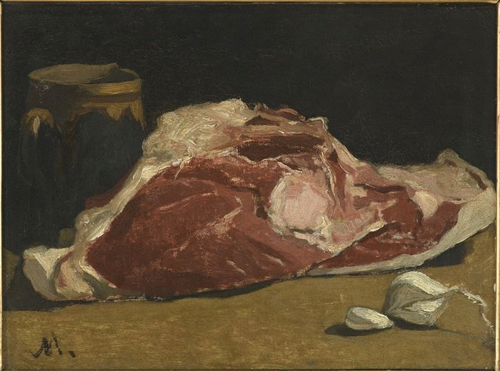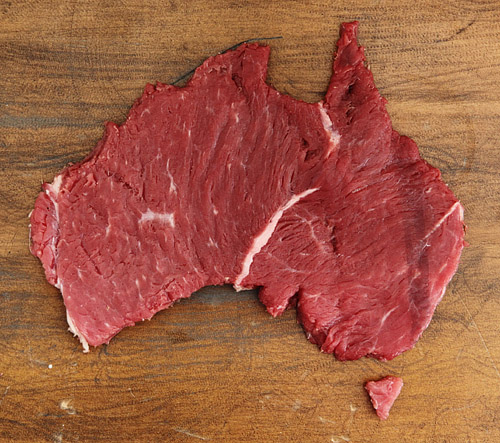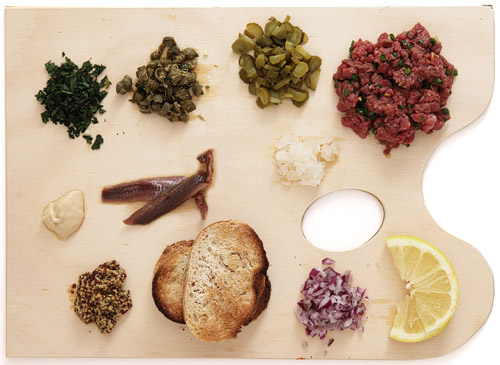In the mid-16th century, Spain began importing a vibrant red pigment from the New World that was so highly sought after that the source was held as a national secret. The dye was extracted from the blood of a female cochineal, a wingless insect that lives upon the leaves of the prickly pear. The dye was so valued that in the late-18th century, a French spy by the name of Nicolas Joseph Thierry de Menonville, snuck into the Spanish territory and successively procured a living specimen. The cochineal insect is closely related to the Indo-European kermes bug. Kermes insects live upon the scarlet oak and the red dye they produce was the most expensive pigment in the middle ages and very valuable to the Romans. According to Victoria Finlay, author of Colour: travels through the paintbox, “for many cultures red is both death and life – a beautiful and terrible paradox.” The connotations this colour, often made from the blood of insects, is embodied in Claude Monet’s Still Life: Quarter of Beef (c.1864). This painting of a dead animal is created – is given life – through the death of the cochineal insect; yet represents a food source that sustains life. The small canvas represents the cyclical and paradoxical nature of the colour red.

oil on canvas, 24 x 33 cm, Musée d’Orsay, Paris
As a leading artist within the Impressionist movement, Claude Monet’s paintings are associated with dreamy landscapes and pastel colours. Before his redundant paintings of haystacks, churches and waterlilies, his work was closer in appearance to his contemporary, Gustav Courbet, whose Realist manner was concerned with the common ‘plebeian’ life. The cut of beef depicted in Monet’s Still Life: Quarter of Beef is an inexpensive and tough piece, typically consumed by the lower class. The garlic would be used to flavour the meal – perhaps in a stew – and the earthenware jug confirms the working-class nature of the tableau. To mimic the paradoxical nature of the colour red, the painting of a plebeian meal is paired with a quintessentially posh recipe for steak tartare. The dish was served in the early-20th century under the name of steak à l’Americane without the egg yolk (also left out of my recipe) and with a side of tartare sauce. Over time, the fare evolved to become an assemblage of raw, minced (not ground) beef, season and topped with a raw egg yolk. Typically the beef is marinated in citrus juice, a Mexican technique that begins to cook the meat and kill off any bacteria. Steak tartare can be served with a variety of accompaniments, a number of which are suggested below.

Steak Tartare
adapted from French by Damien Pignolet
serves 2
1 cup lean rump, trimmed of sinew
½ lemon, juiced
few splashes of Tabasco sauce
1 tsp Worcestershire sauce
drizzle of olive oil
1 tsp lemon zest
1 TB chives
½ tsp sea salt
½ tsp black pepper
Garnishes:
¼ cup cornichons
¼ cup chopped parsley
3 TB capers packed in salt, rinsed
½ red onion
3 TB pickled onions
seeded mustard
anchovy fillets
horseradish crème
lemon wedges
toasted baguette slices rubbed with garlic
Finely chop the rump steak with a clean knife. Do not pass through a mincer otherwise the texture will be like mush. In a bowl, combine with the lemon juice, Tabasco, Worcestershire, olive oil, lemon zest, chives, salt and pepper. Place the marinated meat in a refrigerator to set for two hours.
Toast the baguette and rub each side with a sliced piece of garlic. Finely chop the garnishes and set out with the steak tartare formed into a small mound on each plate. Serve with the toast slices, squeeze of fresh lemon and garnish.

………………………………………………..

11 comments
Big Fan says:
Nov 4, 2010
I really like the color palette of your ingredients.
Tweets that mention Colour Red – Claude Monet – Steak Tartare »Feasting on Art -- Topsy.com says:
Nov 4, 2010
[…] This post was mentioned on Twitter by Nanette Johnson, Megan Fizell and Megan Fizell, La Popoteuse. La Popoteuse said: RT @tresjoliestudio: Map of Australia carved out of meat http://bit.ly/cDE0RH http://twitpic.com/33p804 […]
Anneke says:
Nov 4, 2010
I’m still waiting for the explanation as to why that steak is shaped like Australia …
megan says:
Nov 4, 2010
Because the steak tartare is made from Australian beef
Rosa says:
Nov 4, 2010
I love the shape of this piece of meat… Steak tartare is a lovely dish!
Cheers,
Rosa
Julie says:
Nov 4, 2010
I missed the shape of the meat until it was mentioned, but now that I see it I think it is obvious. How very clever of you! There are so many levels to your work.
deana says:
Nov 4, 2010
I love the romantic take on bug color… it really is a gorgeous red and the painting was completely new to me… I don’t recall ever seeing it before.
As for the tartar… a wonderful restaurant in NYC called 1/5th (Mario Batali has a place there now) made the best steak tartare and chopped it to order… it was spectacular. I miss eating it but have been a little afraid with all the beef scares of late. I guess if I did it myself there would be no worries! Delicious recipe, thanks for the great post.
Suzanne says:
Nov 6, 2010
The pounded meat looks like Australia!
Y says:
Nov 7, 2010
I’m really enjoying this series! Plus the photos themselves are works of art :)
Nik says:
Nov 9, 2010
These look fantastic!
Home Blog / Color Red - Claude Monet - Steak Tartare by COLOURlovers :: COLOURlovers says:
Nov 13, 2010
[…] Color Red – Claude Monet – Steak Tartare By Megan Fizell // 12 November, 20100 comments We're fortunate to have guest authors Megan Fizell & Cassandra Edlefsen share their collaborative colour series here on COLOURlovers. Their monthly colour project considers select artworks featuring one predominant colour within the context of the pigment’s history and in relation to natural edible form. Read more about the project at the bottom of this post. You can find the original articles on Feasting on Art. The one below is located here. […]